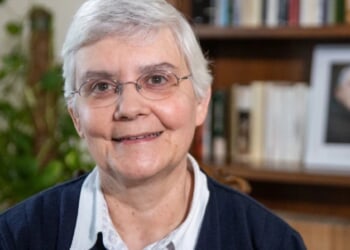
There’s a science behind rehabilitating felons, but one California nonprofit is proving there’s an art to it as well.
Los Angeles-based Creative Acts uses virtual reality in a first-of-its-kind program to astound inmates with views of outer space, immerse them in scenarios at work or with family, and show them how they can change the attitudes that helped put them behind bars.
Within the realm of virtual reality, the inmates can interrogate their actions — and their consequences — while trying out different responses to various situations.
O’Brian Bailey is the acting warden at Valley State Prison, one of four California facilities employing the Virtual Reality Reentry Program offered by Creative Acts. He said he has seen a “complete transformation” in inmates who undertake the program, which he has made mandatory for those nearing release.
Creative Acts Executive Director Sabra Williams said the VR program gives inmates a safe place to drop the macho personas they’ve adopted to survive prison. Once they allow themselves to be vulnerable, they can see the flaws in their old behaviors and embark on a new path forward, she said.
“The current lives that they’re leading, that they thought was the only way of living life because they’ve never seen anything different, is never going to bring them what they want,” said Ms. Williams, an actress and teaching artist by trade. “It’s never going to bring them happiness. It’s never going to bring them a sustainable way of living. … You can’t go on this journey without being accountable for your past.”
The nonprofit group, whose work largely focuses on using the arts to rehabilitate the incarcerated, has run the program for five years at Central California Women’s Facility, Corcoran State Prison, Kern Valley State Prison and Valley State Prison.
The intensive, weeklong program involves four-hour daily sessions with about 10 participants. The pioneering program was inspired by Ms. Williams’ years of working in prisons and seeing how hard it was for ex-cons to reintegrate into society, she said.
— It is funded by state and foundation grants and private donations. It costs roughly $139,000 for the organization to run its program three times a year for 30 participants. By comparison, it costs the state about $133,000 to house a single prisoner each year.
— Each VR module is highly curated and monitored by a Creative Acts team, who can see everything an inmate sees while wearing a Quest VR headset donated by tech giant Meta.
The program begins with a tour of Thailand that includes a boat ride, sightseeing at ruins and witnessing an elephant bath. The inmates are then transported to outer space so they can see the entire world. “We want them to have their minds blown,” Ms. Williams said.
Later, the program focuses on getting through day-to-day activities. Checking out at a grocery store, withdrawing money from an ATM and pumping gas are part of the curriculum.
Ms. Williams said program graduates who were later released said that one of its most high-stress scenarios was encountering their families again. In response, Creative Acts added a Thanksgiving dinner scenario in which program alumni direct interactions and lend their voice-acting skills to the simulation.
“It’s probably one of the most powerful pieces of content, because it was written in collaboration with people who’ve done a lot of time and have come home and have dealt with family issues,” she said. “You see a deeply emotional response to it, and also so much gratitude for being able to prepare in advance.”
Mr. Bailey said he has made the program mandatory for Valley State inmates who are scheduled to be released within the next six to nine months so they can learn key skills to navigate public life.
For example, he said the program reinforces the value of patience by making inmates endure a slow-moving line at the Department of Motor Vehicles.
It also shows prisoners how to resolve conflicts peacefully. The warden said another virtual scenario has the inmates waiting to use the pull-up bar at the gym when a man cuts in front of them. He said the VR program shows the inmates three different outcomes for the situation — one is to fight the guy, one is to have a conversation with him and the other ends with the two working out together.
Mr. Bailey said the VR simulations, coupled with discussions held at the end of each day’s session, are one of the best forms of therapy the inmates can experience.
“A therapist, a bad one, will let you go there and rehash all the bad things that you’ve done [and] are ashamed of, and then say, ’Cool, see you next week,’” he said. “The thing that Creative Acts does is they say … ’These are some of the tools you could use to address that,’ and they give you homework to work on until the next meeting.”
Since he became acting warden in July, about 90 inmates have worked with Creative Acts at his facility, Mr. Bailey said, adding that inmates’ desire to participate in the program is “contagious.”
California officials and administrators at other prisons where the program is offered did not immediately respond to requests for comment.
Ms. Williams said limiting funding is keeping the program focused on the four California prisons where it is currently administered, despite interest from officials in Maine, Colorado and Illinois.
She said she’s most grateful for the lessons she’s learned while watching the inmates undergo their own lifestyle changes.
“To see humans become accountable for some of the worst things that you could have done in your life, it makes me think I should be accountable for the s— things that I’ve done in my life too. If they can, I can,” Ms. Williams said.





![Jasmine Crockett Justifies Mass Illegal Immigration With Bizarre Argument [WATCH]](https://www.right2024.com/wp-content/uploads/2025/03/1742007023_Jasmine-Crockett-Justifies-Mass-Illegal-Immigration-With-Bizarre-Argument-WATCH-350x250.jpg)

![NYC Tourist Helicopter Falls into Hudson River, Siemens Executive and Family Among Those Killed [WATCH]](https://www.right2024.com/wp-content/uploads/2025/04/NYC-Tourist-Helicopter-Falls-into-Hudson-River-Siemens-Executive-and-350x250.jpg)








